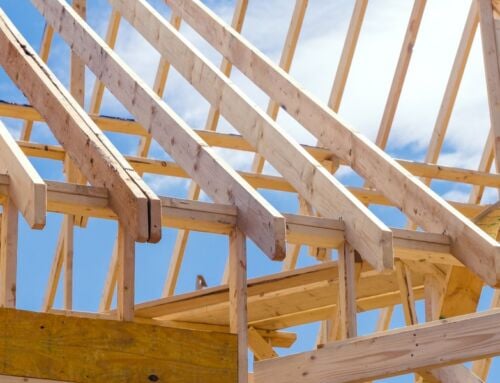A home renovation project involves juggling many complex and time-sensitive tasks. As a contractor, you are not only responsible for the physical transformation of a space but also for ensuring that the process runs as smoothly as possible. It’s not uncommon for unexpected issues to arise, and each renovation project can present its own unique challenges.
To help your contracting business navigate these complexities, we spoke with the Ontario Home Builder’s Association (OHBA) and put together a list of risk management tips that you can use before and during a home renovation project.
Before you start a renovation
There are a few key steps to take before your renovation begins:
Getting the right permit
It’s important that your business applies for the right permit, which will depend on the type of work you are doing. Generally, a permit is needed any time you deal with structural change, electrical, plumbing, or HVAC In most cases, a permit is not required for general maintenance, such as flooring or painting.
However, rules and regulations can vary by region. For example, if you’re a contractor based outside of the city but working on a renovation in Toronto, it’s important to understand their specific regulations, such as the need for a license. This is key, especially if you’re looking to expand as a business.
Understanding your client profile
Many businesses get involved in contractual arrangements without understanding their client’s profile. Businesses should focus on developing a target market based on their company’s unique skills and goals. Are your clients long-term homeowners? Do they want to remodel or have a custom home? Asking these questions can help you identify your ideal customer, especially if you are new to the industry. A detailed client profile also allows you to tailor your marketing and sales tactics to target this specific audience and provides insights into your business’ strengths and weaknesses.
It can also help you to understand the neighbourhood you will be working in, and what response you might get to any type of outdoor construction. For instance, if trucks are coming in, you should inform your client so they can give their neighbours advance warning.
Setting expectations
When you create the contract, it’s essential to ensure your client clearly understands what type of work is going to happen and what the payment requirements are. A clear scope of work should be developed that defines everything included in a project and a list of what is excluded. You should also include what will happen if there’s a dispute or delay during the project, along with possible solutions.
It’s important that you and your client understand how the contract works. Active communication from both of you at every stage is important. As the contractor, you need to communicate what you need. The OHBA suggests scheduling weekly meetings with set agendas to review scope, changes, progress, schedule, budget and to address any client issues.. As the client, they need to communicate concerns as soon as they arise. The CHBA’s “Get it in Writing” initiative encourages the use of contracts, for the benefit of both contractors and clients.
Common challenges during a renovation
Once you have secured all the necessary permits and a signed contract, you can begin to tackle your renovation. It’s important to understand that no matter how prepared you are, you may still face challenges along the way. Establishing open channels of communication and building a relationship with your client can help you get the job done well.
Navigating client expectations
Renovations are an intimate business – when you’re working in someone’s home, you’re in their personal space. Every time you leave, they’ll likely walk around and look at what you did. This may lead to misunderstandings, but there will also be moments of clarity.
As a business, it’s your responsibility to manage client expectations when there is a setback. For example, if a client picks out a kitchen counter that becomes unavailable even though you, as the contractor, said it would be, it’s your responsibility to ensure the client receives clear communication and still feels like they’re getting what they want. First, tell them about the situation and provide them with alternative options and solutions. If it isn’t available for the next twelve weeks, you can suggest another material in the meantime. You can also suggest options that you have confirmed will be available sooner, and let the client decide. Such situations will be best managed with a strong scope of work in place, and weekly update meetings.
Payment structure and draw pay
Compensation may be another issue your business runs into during a renovation. This is why clearly defining the payment structure in your contract beforehand is essential. It’s common practice to outline a process for draw pay, which is an advance of money held and paid on a predefined date.
Clients will often question the draw pay, especially when work doesn’t proceed as planned. It’s important to explain that the draws are set up this way because you have supplies sitting in storage that your business needs to pay for. Here is an example of what this could look like:
The total cost of the job is $<insert number here>. We need 15% before we start, and four draws over the course of <insert time period>.
Money can be a sensitive subject, so include specific wording about when you need a deposit and how the rest of the payment will be collected. Finalize this contract, so that even if there is a bump in the road, you still get a draw. All that changes is your final invoice.
Tips to help minimize expenses
Managing costs effectively is crucial for contractors when taking on a home renovation project. From labor to materials and equipment, expenses can quickly add up. Here are some tips to help you maximize your budget:
Storing materials onsite
This can help keep your costs down and provide transparency to clients. For example, on occasion it may be possible to deliver hardwood a week before installation to show your client what they’re paying for. This should only be done when there is adequate secure space to store the materials to help prevent damage, and theft, as well as alleviate any safety concerns.
Scheduling work efficiently
If you can, arrange your schedule so that workers you need to supervise are onsite at the same time. For example, if you have an HVAC person and supervisor coming in, try and schedule them both at the same time. If you’re going to be there to supervise one, you should try to arrange the schedule so that you can supervise both.
Setting a contingency period
Be clear about how long the reno will take, keeping in mind the likelihood of delays. If a project is estimated to take eight weeks, give your business ten to get the job done. This two-week contingency period provides a buffer in case something goes wrong.
Contractor’s insurance can help protect your renovation project
We partner with leading industry associations, including the Ontario Home Builder’s Association (OHBA), to make sure businesses in contracting and skilled trades have reliable coverage when they take on projects like home renovations.
A tailored insurance solution can help safeguard your business against the unique risks that could derail your project, such as liability, auto, and property losses. Learn more by visiting our Contractor’s Insurance page today!
About the Ontario Home Builders Association (OHBA)
The Ontario Home Builder’s Association (OHBA) represents the residential construction industry in Ontario, with 4,000 member companies organized into 27 local associations across the province. They provide resources and support for businesses taking on home renovations.
This blog is provided for information only and is not a substitute for professional advice. We make no representations or warranties regarding the accuracy or completeness of the information and will not be responsible for any loss arising out of reliance on the information.






